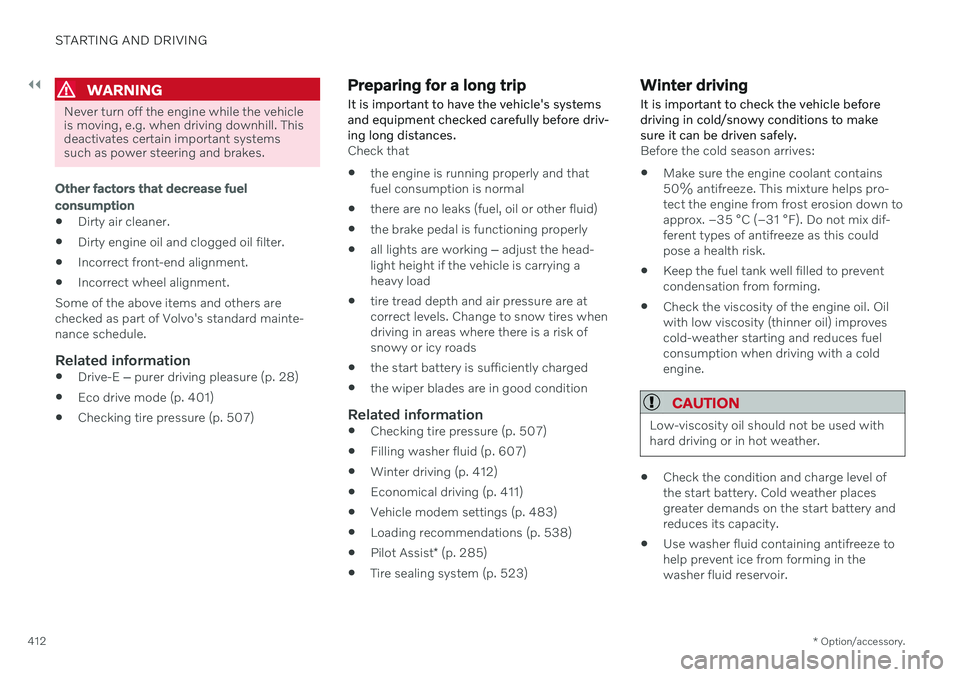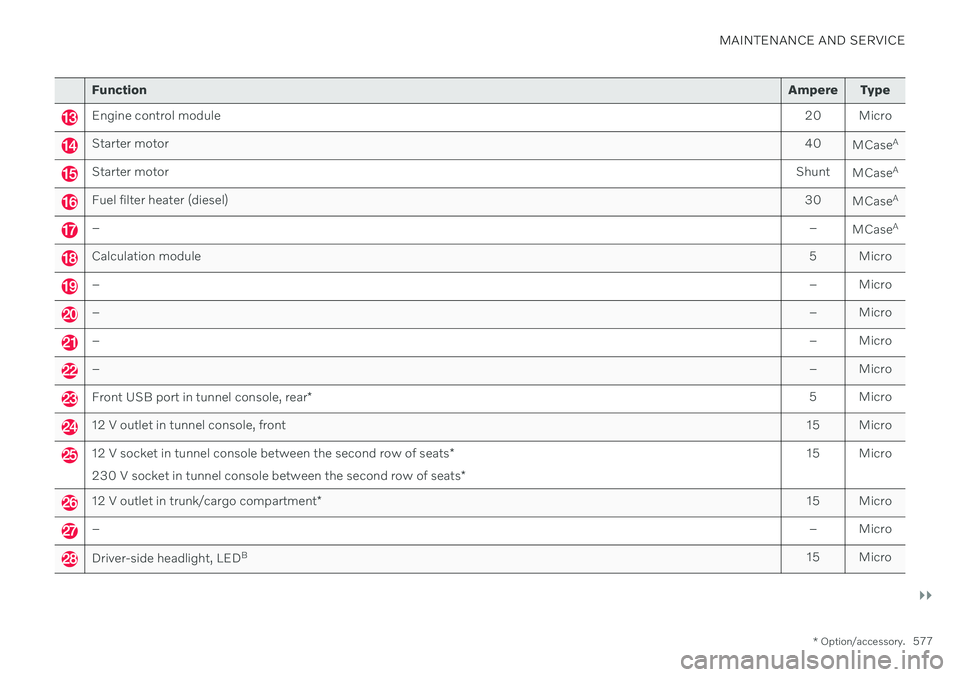fuel filter VOLVO S90 2020 Quick Guide
[x] Cancel search | Manufacturer: VOLVO, Model Year: 2020, Model line: S90, Model: VOLVO S90 2020Pages: 643, PDF Size: 13.68 MB
Page 414 of 643

||
STARTING AND DRIVING
* Option/accessory.
412
WARNING
Never turn off the engine while the vehicle is moving, e.g. when driving downhill. Thisdeactivates certain important systemssuch as power steering and brakes.
Other factors that decrease fuel consumption
Dirty air cleaner.
Dirty engine oil and clogged oil filter.
Incorrect front-end alignment.
Incorrect wheel alignment.
Some of the above items and others are checked as part of Volvo's standard mainte-nance schedule.
Related information
Drive-E
‒ purer driving pleasure (p. 28)
Eco drive mode (p. 401)
Checking tire pressure (p. 507)
Preparing for a long trip
It is important to have the vehicle's systems and equipment checked carefully before driv-ing long distances.
Check that
the engine is running properly and that fuel consumption is normal
there are no leaks (fuel, oil or other fluid)
the brake pedal is functioning properly
all lights are working
‒ adjust the head-
light height if the vehicle is carrying aheavy load
tire tread depth and air pressure are atcorrect levels. Change to snow tires whendriving in areas where there is a risk ofsnowy or icy roads
the start battery is sufficiently charged
the wiper blades are in good condition
Related information
Checking tire pressure (p. 507)
Filling washer fluid (p. 607)
Winter driving (p. 412)
Economical driving (p. 411)
Vehicle modem settings (p. 483)
Loading recommendations (p. 538)
Pilot Assist
* (p. 285)
Tire sealing system (p. 523)
Winter driving
It is important to check the vehicle before driving in cold/snowy conditions to makesure it can be driven safely.
Before the cold season arrives: Make sure the engine coolant contains 50% antifreeze. This mixture helps pro-tect the engine from frost erosion down toapprox. –35 °C (–31 °F). Do not mix dif-ferent types of antifreeze as this couldpose a health risk.
Keep the fuel tank well filled to preventcondensation from forming.
Check the viscosity of the engine oil. Oilwith low viscosity (thinner oil) improvescold-weather starting and reduces fuelconsumption when driving with a coldengine.
CAUTION
Low-viscosity oil should not be used with hard driving or in hot weather.
Check the condition and charge level of the start battery. Cold weather placesgreater demands on the start battery andreduces its capacity.
Use washer fluid containing antifreeze tohelp prevent ice from forming in thewasher fluid reservoir.
Page 555 of 643

MAINTENANCE AND SERVICE
}}
553
Hood completely closed.
WARNING
Never drive with the hood open! If this symbol appears, or anything else indicatesthat the hood is not com-pletely closed while driv-ing, stop immediately and
close it properly.
Related information
Engine compartment overview (p. 553)
Door and seat belt reminders (p. 51)
Engine compartment overview
This overview shows some service-related components.
The layout of the engine compartment may vary depending on model and engine variant.
Coolant expansion tank
Brake fluid reservoir (located on the driv- er's side)
Washer fluid filler pipe 12
Fusebox
Air filter
Engine oil filler pipe
WARNING
Bear in mind that the cooling fan (located at the front of the engine compartmentbehind the radiator) may start or continuerunning automatically up to about6 minutes after the engine is turned off. Always entrust engine washing to a work- shop – an authorized Volvo workshop isrecommended. If the engine is hot, there isa risk of fire.
WARNING
The ignition system works with extremely high and dangerous voltages. The vehicleelectrical system should always be in igni-tion mode
0 when work in being per-
formed in the engine compartment. Do not touch any spark plugs or ignition coils when the vehicle electrical system isin ignition mode II or when the engine is
warm.
Related information
Opening and closing the hood (p. 552)
Filling washer fluid (p. 607)
Refilling coolant (p. 556)
Fuses in the engine compartment (p. 575)
12
Fill the washer fluid at regular intervals, e.g. when refueling.
Page 579 of 643

MAINTENANCE AND SERVICE
}}
* Option/accessory.577
Function Ampere Type
Engine control module 20 Micro
Starter motor40
MCaseA
Starter motor
Shunt
MCaseA
Fuel filter heater (diesel)
30
MCaseA
–
–
MCaseA
Calculation module
5 Micro
–– Micro
–– Micro
–– Micro
–– Micro
Front USB port in tunnel console, rear* 5 Micro
12 V outlet in tunnel console, front
15 Micro
12 V socket in tunnel console between the second row of seats*
230 V socket in tunnel console between the second row of seats *15 Micro
12 V outlet in trunk/cargo compartment
* 15 Micro
–
– Micro
Driver-side headlight, LEDB
15 Micro
Page 629 of 643

INDEX
627
E
ECO climate 401
ECO mode 401activate with function button 404
Economical driving 401, 411
Electrical outlet 534 use 534
Electrical system 567
Electric parking brake 385
Electronic immobilizer 246
emergency brake lights 157
Emission inspection readiness 542 Engine overheating 418
start 378
Start/Stopfunction 404
turn off 380
Engine braking 383 Engine compartment coolant 556
engine oil 554
overview 553
Engine drag control 267
Engine oil 554 filling 555
filter 554
grade and volume 617
Engine shutdown 380
Engine specifications 616Engine temperature high 418
Environment 28Ethanol content max. 10% by volume 415
Exterior dimensions 613
F
Federal Clean Air Act 542
Ferry transport 408
Flooded road 413
Fluids, volumes 607, 619
Fluids and oils 618, 619 Fog lights front 155
rear 156
Four-C 408 Front seat blower 217
climate 207
heating 209, 210
temperature 220
ventilation 211
Front seat manual 182
Front seats, power 183 adjusting passenger seat from driv-
er's seat 191
adjusting seat 183
Lumbar support 189
massage 186, 187, 188
multifunction control 186, 187, 188, 189
Side bolsters 189
store position 184, 185
Fuel 415 Travel Link service 453
Fuel filling 414
Fuel gauge 85
Fuel requirements 415, 416 Fuel tank volume 619
Fuse box 573
Fuses 573 below the glove compartment 580
in engine compartment 575
in trunk 586
replacing 574